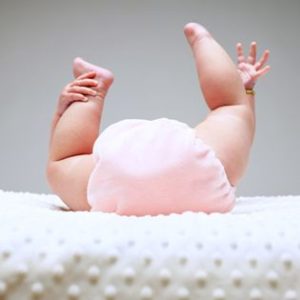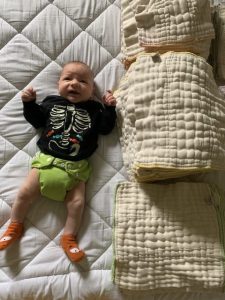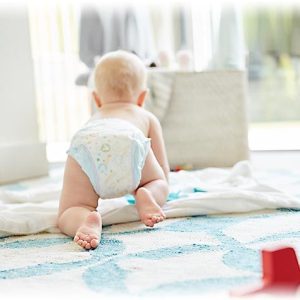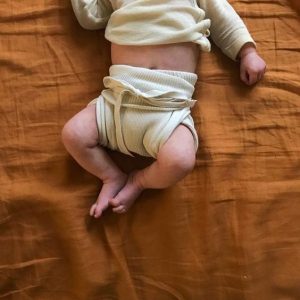Cloth diapers are a popular choice for many parents. They’re reusable, eco-friendly, and can save money in the long run. But how exactly do they work? This article explores the different parts of a cloth diaper and explains how they absorb and contain waste.
Understanding the Basics
People made cloth diapers from absorbent fabrics that trap moisture. Unlike disposable diapers, which use chemicals to absorb liquid, cloth diapers rely on physical absorption. Here’s a breakdown of the two main parts of a cloth diaper:
Inner Absorbent Layer:
This layer is made from soft, absorbent fabrics like cotton, hemp, or bamboo. It directly touches your baby’s skin and wicks away moisture.
Waterproof Outer Cover:
This layer is made from a waterproof material like PUL (polyurethane laminate) or fleece. It prevents leaks and keeps your baby dry.
Some cloth diapers are all-in-one designs, combining the absorbent layer and waterproof cover in one piece. Other cloth diapers are two-part systems, with separate absorbent inserts and waterproof covers.

How Cloth Diapers Absorb
The absorbent layer of a cloth diaper is the key to its functionality. Here’s a closer look at how it works:
-
Fabric Choice: Fabrics like cotton, hemp, and bamboo have tiny spaces between the fibers. These spaces allow the fabric to trap and hold liquid.
-
Wicking Action: As moisture touches the fabric, it’s drawn away from your baby’s skin through a process. This helps keep your baby comfortable and prevents irritation.
-
Saturation: The absorbent layer can only hold a certain amount of liquid. Once saturated, the diaper will become wet and may leak.
The thickness and material of the absorbent layer will affect how much liquid a cloth diaper can hold. Some diapers have additional inserts that can be added for increased absorbency for nighttime use or heavy wetters.
Types of Cloth Diapers
There are many different types of cloth diapers available, each with its own advantages and disadvantages. Here are a few common types:
-
Prefolds: These are rectangular pieces of absorbent fabric that can be folded into different shapes to fit your baby.
-
Fitted Diapers: These resemble disposable diapers in shape and have an absorbent core throughout.
-
Pocket Diapers: These have a waterproof cover with a pocket where you insert separate absorbent inserts.
-
All-in-One (AIO) Diapers: These combine the absorbent layer and waterproof cover in one piece, similar to a disposable diaper.
Choosing the right type of cloth diaper for your baby depends on your preferences, budget, and your baby’s needs.

Keeping Your Baby Comfortable
Cloth diapers are designed to be soft and gentle on your baby’s skin. Here are some tips for keeping your baby comfortable:
-
Choose the right size: A properly fitting diaper will help prevent leaks and ensure your baby’s comfort.
-
Change diapers frequently: Just like with disposable diapers, change cloth diapers whenever they are soiled or wet to prevent diaper rash.
-
Use a diaper cream: Apply a barrier cream to protect your baby’s skin from irritation caused by moisture.
-
Wash diapers properly: Regular cleaning is essential to maintain the absorbency of cloth diapers and prevent odors.
With a little practice, cloth diapering can be a rewarding and eco-friendly way to care for your baby.

Boosting Absorbency for Peace of Mind
Cloth diapers are fantastic for many reasons, but sometimes you might want some extra assurance, especially at night or for heavy wetters. Here are some ways to boost the absorbency of your cloth diapers:
-
Double Up Inserts: Many pocket diapers allow for additional inserts. Adding another insert can significantly increase absorbency.
-
Nighttime Doubling: For nighttime use, consider doubling up the inserts or using specifically designed nighttime inserts that are extra thick and absorbent.
-
Hemp or Bamboo Inserts: Hemp and bamboo are naturally absorbent fabrics. If you’re using cotton inserts, consider trying hemp or bamboo for increased absorbency.
-
Older Baby, Bigger Diaper: As your baby grows, they might need diapers with more absorbency. Some one-size-fits-most diapers have adjustments to accommodate this.
Remember, every baby is different. Experiment with different insert combinations and types of diapers to find what works best for your little one.

Benefits of Cloth Diapers
Cloth diapering offers many advantages over disposable diapers:
-
Eco-Friendly: Disposable diapers create a lot of landfill waste. Cloth diapers are reusable and have a smaller environmental footprint.
-
Cost-Effective: While there’s an initial investment in cloth diapers, they can save you money in the long run compared to buying disposable diapers for several years.
-
Gentle on Skin: People made Cloth diapers from soft, breathable fabrics that can be gentler on your baby’s skin than disposable diapers.
-
Cute and Colorful: Cloth diapers come in a wide variety of adorable prints and colors, which can be a fun perk for parents.
It can be a great choice for parents who are eco-conscious, budget-minded, and want the best for their baby’s skin.
Cloth diapers are a reliable and effective way to keep your baby comfortable and dry. By understanding how they work and exploring different options, you can find a cloth diapering routine that works for you and your baby. Remember, there are many resources available to help you on your cloth diapering journey!

Putting It All Together: Cloth Diapering for Beginners
Cloth diapers offer a unique system for keeping your baby comfortable and dry. Here’s a recap of the key components and how they work together:
-
Inner Absorbent Layer: This soft fabric layer, typically made from cotton, hemp, or bamboo, wicks moisture away from your baby’s skin to keep them comfortable.
-
Waterproof Outer Cover: This layer acts as a barrier to prevent leaks. It’s usually made from a waterproof material like PUL (polyurethane laminate) or fleece.
-
Fit and Sizing: A well-fitting diaper is essential to prevent leaks and ensure comfort. Look for adjustable features or different size options to find the perfect fit for your baby.
There are two main types of cloth diaper systems:
-
All-in-One (AIO) Diapers: These combine the absorbent layer and waterproof cover in one piece, similar to a disposable diaper.
-
Two-Part Systems: These involve separate components – an absorbent insert placed inside a waterproof cover. Prefolds, fitted diapers, and pocket diapers are all examples of two-part systems.





